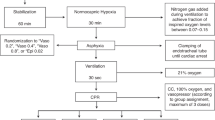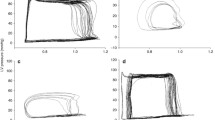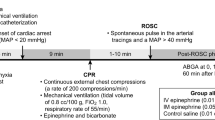Abstract
Background
After resuscitation, asphyxiated neonates often develop poor cardiac function with hypotension, pulmonary hypertension and multiorgan ischemia. In a swine model of neonatal hypoxia-reoxygenation, effects of epinephrine, dobutamine and milrinone on systemic, pulmonary and regional hemodynamics and oxygen transport were compared.
Design
Controlled, block-randomized study.
Setting
University research laboratory.
Subject
Mixed breed piglets (1–3 days, 1.5–2.3 kg).
Interventions
In acutely instrumented piglets, normocapnic alveolar hypoxia (10–15% oxygen) was induced for 2 h followed by reoxygenation with 100% oxygen (1 h) then 21% oxygen (3 h). At 2 h of reoxygenation, after volume loading (Ringer’s lactate 10 ml/kg), either saline (placebo), epinephrine (0.5 μg/kg/min), dobutamine (20 μg/kg/min) or milrinone (0.75 μg/kg/min) were infused for 2 h in a blinded, block-randomized fashion (n = 6/group).
Main results
All medications similarly improved cardiac output, stroke volume and systemic oxygen delivery (vs. placebo-controls, p < 0.05). Epinephrine and dobutamine significantly increased, while milrinone maintained, mean arterial pressure over pretreatment values while placebo-treated piglets developed hypotension and shock. The mean arterial to pulmonary arterial pressures ratio was not different among groups. All medications significantly increased carotid and intestinal, but not renal, arterial blood flows and oxygen delivery, whereas milrinone caused lower renal vascular resistance than epinephrine and dobutamine-treated groups. Plasma troponin I, plasma and myocardial lactate levels, and histologic ischemic features were not different among groups.
Conclusions
In newborn piglets with hypoxia-reoxygenation, epinephrine, dobutamine and milrinone are effective inotropes to improve cardiac output, carotid and intestinal perfusion, without aggravating pulmonary hypertension. Milrinone may also improve renal perfusion.





Similar content being viewed by others
Abbreviations
- CAF:
-
Carotid arterial blood flow
- CO:
-
Cardiac output
- H-R:
-
Hypoxia-reoxygenation
- MAP:
-
Mean arterial pressure
- PAP:
-
Pulmonary arterial pressure
- PHT:
-
Pulmonary hypertension
- RAF:
-
Renal arterial blood flow
- SMAF:
-
Superior mesenteric arterial blood flow
- VR:
-
Vascular resistance
References
van Bel F, Walther FJ (1990) Myocardial dysfunction and cerebral blood flow velocity following birth asphyxia. Acta Paediatr Scand 79:756–762
Leuthner SR, Das UG (2004) Low Apgar scores and the definition of birth asphyxia. Ped Clin N Am 51:737–745
Evans N, Kluckow M, Currie A (1998) Range of echocardiographic findings in term neonates with high oxygen requirements. Arch Dis Child Fetal Neonatal Ed 78:F105–F111
Shah P, Riphagen S, Beyene J, Perlman M (2004) Multiorgan dysfunction in infants with post asphyxial hypoxic ischemic encephalopathy. Arch Dis Child Fetal Neonatal Ed 89:152–155
Martin-Ancel A, Garcia-Alix A, Gaya F, Gabañas F, Burgueros M, Quero J (1995) Multiple organ involvement in perinatal asphyxia. J Pediatr 127:786–793
Perlman JM, Ed Tack, Martin T, Shackelford G, Amon E (1989) Acute systemic organ injury in term infants after asphyxia. Am J Dis Child 143:617–620
Evans N (2006) Which inotrope for which baby? Arch Dis Child Fetal Neonatal Ed 91:213–220
Young TE, Magnum B (2008) Neofax 2008. Thomson Reuters, Montvale, NJ, pp 124, 128, 136
Subhedar NV (2003) Treatment of hypotension in newborns. Sem Neonat 8:413–423
Chatterjee K, De Marco T (2003) Role of nonglycoside inotropic agents: indications, ethics and limitations. Med Clin N Am 87:391–418
Penny DJ, Sano T, Smolich JJ (2001) Increased systemic oxygen consumption offsets improved oxygen delivery during dobutamine infusion in newborn lambs. Intensive Care Med 27:1518–1525
Al-Salam Z, Johnson ST, Abozaid S, Bigam DL, Cheung PY (2007) The hemodynamic effects of dobutamine during reoxygenation after hypoxia: a dose-response study in newborn pigs. Shock 28:317–325
Obaid L, Johnson ST, Emara M, Bigam DL, Cheung PY (2008) Epinephrine versus dopamine to treat shock in hypoxic newborn pigs resuscitated with 100% oxygen. Shock 29:262–268
Cheung PY, Barrington KJ (2001) The effects of dopamine and epinephrine on hemodynamics and oxygen metabolism in hypoxic anesthetized piglets. Crit Care 5:158–168
Wessel DL (2001) Managing low cardiac output syndrome after congenital heart surgery. Crit Care Med 29:S220–S230
Simonton CA, Chatterjee K, Cody RJ, Jubo SH, Leonard D, Daly P, Rutman H (1985) Milrinone in congestive heart failure: acute and chronic hemodynamics and clinical evaluation. J Am Coll Cardiol 6:453–459
Monrad ES, McKay RG, Baim DS, Colucci WS, Fifer MA, Heller GV, Royal HD, Grossman W (1984) Improvement in index of diastolic performance in patients with congestive heart failure treated with milrinone. Circulation 70:1030–1037
Chang AC, Atz AM, Wernovsky G, Burke RP, Wessel DL (1995) Milrinone: systemic and pulmonary hemodynamic effects in neonates after cardiac surgery. Crit Care Med 23:1907–1914
Duggal B, Pratap U, Slavik Z, Kaplanova J, Macrae D (2005) Milrinone and low cardiac output following cardiac surgery in infants: is there a direct myocardial effect. Pediatr Cardiol 26:642–645
Bassler D, Choong K, McNamara P, Kirpalani H (2006) Neonatal persistent pulmonary hypertension treated with milrinone: four case reports. Biol Neonate 89:1–5
Danhaive O, Margossian R, Geva T, Kourembanas S (2005) Pulmonary hypertension and right ventricular dysfunction in growth restricted, extremely low birth weight neonates. J Perinat 25:495–499
Hoffman TM, Wernovsky G, Atz AM, Kulik TJ, Nelson DP, Chang AC, Bailey JM, Akbary A, Kocsis JF, Kaczmarek R, Spray TL, Wessel DL (2003) Efficacy and safety of milrinone in preventing low cardiac output syndrome in infants and children after corrective surgery for congenital heart disease. Circulation 107:996–1002
Paradisis M, Evans N, Kluckow M, Osborn D, McLachlan AJ (2006) Pilot study of milrinone for low systemic blood flow in very preterm infants. J Pediatr 148:306–313
Joynt CA, Bigam DL, Charrois G, Jewell LD, Korbutt G, Cheung PY (2008) Dose-response effects of milrinone on hemodynamics of newborn pigs with hypoxia-reoxygenation. Intensive Care Med 34:1321–1329
Haase E, Bigam DL, Nakonechny QB, Jewell LD, Korbutt G, Cheung PY (2004) Resuscitation with 100% oxygen causes intestinal glutathione oxidation and reoxygenation injury in asphyxiated newborn piglets. Ann Surg 240:364–373
Passonneau JV, Lowry OH (1993) Enzymatic analysis. A practical guide. Humana Press, Totowa
Rose AG, Opie LH, Bricknell OL (1976) Early experimental myocardial infarction: evaluation of histologic criteria and comparison with biochemical and electrocardiographic measurements. Arch Pathol Lab Med 100:574–580
Park PO, Haglund U, Bilkley GB, Falt K (1990) The sequence of development of intestinal tissue injury after strangulation ischemia and reperfusion. Surgery 107:574–580
Devictor D, Verlhac S, Pariente D, Huault G (1988) Hemodynamic effects of dobutamine in asphyxiated newborn infants. Arch Fr Pediatr 45:467–470
Cheung PY, Barrington KJ, Bigam DL (1999) The hemodynamic effects of dobutamine infusion in chronically instrumented newborn piglet. Crit Care Med 27:558–564
Pellicer A, Valverde E, Elorza MD, Madero R, Gaya F, Quero J, Cabañas F (2005) Cardiovascular support for low birth weight infants and cerebral hemodynamics: a randomized, blinded clinical trial. Pediatrics 115:1501–1512
Quaedackers JS, Roelfsema V, Heineman E, Gunn AJ, Bennet L (2004) The role of the sympathetic nervous system in post-asphyxial intestinal hypoperfusion in the preterm sheep fetus. J Physiol 557:1033–1044
Bennet L, Booth L, Malpas SC, Quaedackers JS, Jensen E, Dean, Gunn AJ (2006) Acute systemic complications in the preterm fetus after asphyxia: Role of cardiovascular and blood flow responses. Clin Exper Pharm Phys 33:291–299
Weindling AM, Kissack CM (2001) Blood pressure and tissue oxygenation in the newborn baby at risk of brain damage. Biol Neonate 79:241–245
Pryds O, Edwards AD (1996) Cerebral blood flow in the newborn infant. Arch Dis Child Fetal Neonatal Ed 74:63–69
Seri I, Evans J (2001) Controversies in the diagnosis and management of hypotension in the newborn infant. Curr Opin Pediatr 13:116–123
Caspi J, Coles JG, Benson LN, Herman SL, Diaz RJ, Augustine J, Brezina A, Kolin A, Wilson GT (1991) Age related response to epinephrine induced myocardial stress A functional and ultrasound study. Circulation 84:III394–III395
Dakshinamurti S (2005) Pathophysiologic mechanisms of persistent pulmonary hypertension of the newborn. Pediatr Pulmonol 39:492–503
Phillipos EZ, Robertson MA (1995) A randomized double blinded controlled trial of dopamine versus epinephrine on pulmonary arterial pressure in premature infants <1750 grams. Pediatr Res 47:425 (Abstract)
Cheung PY, Barrington KJ, Pearson RJ, Bigam DL, Finer NN, Van Aerde JE (1997) Systemic, pulmonary and mesenteric perfusion and oxygenation effects of dopamine and epinephrine. Am J Respir Crit Care Med 155:32–37
Barrington KJ, Finer NN, Chan W (1995) A blind, randomized comparison of the circulatory effects of dopamine and epinephrine infusions in the newborn piglet during normoxia and hypoxia. Crit Care Med 23:740–748
Pourcyrous M, Parfenova H, Bada HS, Korones SB, Leffler CW (1997) Changes in cerebral cyclic nucleotides and cerebral blood flow during prolonged asphyxia and recovery in newborn pigs. Pediatr Res 41:617–623
Pryds O, Greisen G, Lou H, Fris-Hansen B (1990) Vasoparalysis is associated with brain damage in asphyxiated term infants. J Pediatr 117:119–125
Cerchiari EL, Hoet TM, Safar P, Sclabassi RJ (1987) Protective effects of combined superoxide dismutase and deferoxamine on recovery of cerebral blood flow and function after cardiac arrest in dogs. Stroke 18:869–878
Touloukian RJ, Pocsh JW, Spenser R (1972) The pathogenesis of ischemic gastroenterocolitis of the neonate: selective get mucosal ischemia in asphyxiated neonatal piglets. J Pediatr Surg 7:194–205
Swindle M (1985) Porcine models in surgical research: an overview. In: Tumbleson M (ed) Swine in biomedical research, vol 1. Plenum Press, New York, pp 235–242
Gootman PM (1985) Cardiovascular regulation in developing swine. In: Tumbleson M (ed) Swine in biomedical research, vol 2. Plenum Press, New York, pp 1161–1175
Borke WB, Munkeby BH, Halvorsen B, Bjornland K, Tunheim SH, Borge GI, Thaulow E, Saugstad OD (2004) Increased myocardial matrix metalloproteinases in hypoxic newborn pigs during resuscitation: effects of oxygen and carbon dioxide. Eur J Clin Invest 34:459–466
Markus T, Hansson S, Amer-Wåhlin I, Hellström-Westas L, Saugstad OD, Ley D (2007) Cerebral inflammatory response after fetal asphyxia and hyperoxic resuscitation in newborn sheep. Pediatr Res 62:71–77
Acknowledgments
The project was funded by operating grants from the Canadian Institutes of Health Research and Stollery Children’s Hospital Foundation. CJ received support from the Clinician Investigator Program of the Royal College of Physicians and Surgeons of Canada and Clinical Fellowship Program of the Alberta Heritage Foundation for Medical Research. PYC is an investigator of the Canadian Institutes of Health Research and the Alberta Heritage Foundation for Medical Research.
Author information
Authors and Affiliations
Corresponding author
Electronic supplementary material
Below is the link to the electronic supplementary material.
Rights and permissions
About this article
Cite this article
Joynt, C., Bigam, D.L., Charrois, G. et al. Milrinone, dobutamine or epinephrine use in asphyxiated newborn pigs resuscitated with 100% oxygen. Intensive Care Med 36, 1058–1066 (2010). https://doi.org/10.1007/s00134-010-1820-x
Received:
Accepted:
Published:
Issue Date:
DOI: https://doi.org/10.1007/s00134-010-1820-x




